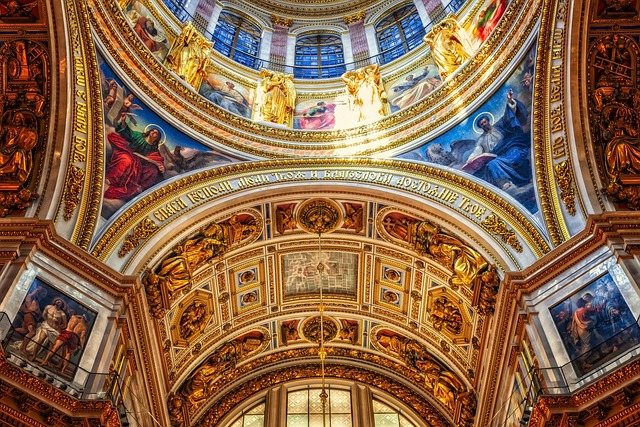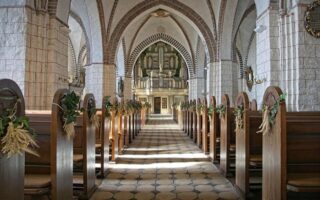The Orthodox Church traces its origins back to the early Christian community established by Jesus Christ and his apostles in the 1st century AD. It emerged as one of the major branches of Christianity, alongside the Roman Catholic Church, following the Great Schism of 1054. The Orthodox Church’s foundation is rooted in the teachings and traditions of the early Christian Church, with its liturgical practices and theological beliefs influenced by the early Church Fathers. Over the centuries, the Orthodox Church has developed its own distinct identity, encompassing various regional traditions and cultural influences. Today, it remains one of the largest Christian denominations worldwide, with a rich history and a significant presence in Eastern Europe, the Middle East, and other parts of the world.
Table of Contents
The Origins of the Orthodox Church
The Orthodox Church, with its rich history and deep-rooted traditions, has been a pillar of Christianity for centuries. But have you ever wondered how it all began? In this article, we will delve into the origins of the Orthodox Church, tracing its roots back to the early days of Christianity.
The story of the Orthodox Church begins with the life and teachings of Jesus Christ. It was during his ministry that the foundation for the Church was laid. Jesus appointed twelve apostles to carry on his work and spread his message of love and salvation. These apostles became the first leaders of the Church, and their teachings formed the basis of what would later become known as Orthodox Christianity.
After the crucifixion and resurrection of Jesus, the apostles embarked on a mission to spread the Gospel throughout the world. They traveled far and wide, preaching and baptizing believers in the name of Christ. As they journeyed, they established communities of believers, known as churches, in various regions.
One of the most significant events in the early history of the Orthodox Church was the Pentecost. It was on this day, fifty days after Jesus’ resurrection, that the Holy Spirit descended upon the apostles, empowering them to carry out their mission. This event marked the birth of the Church, as the apostles were filled with the Spirit and began to speak in different languages, enabling them to communicate with people from all walks of life.
As the Church grew, it faced numerous challenges and obstacles. The Roman Empire, under the rule of Emperor Nero, persecuted Christians, viewing them as a threat to the established order. Many believers were martyred for their faith, but this only served to strengthen the resolve of the early Christians.
In the fourth century, a significant turning point occurred in the history of the Orthodox Church. Emperor Constantine, who had converted to Christianity, issued the Edict of Milan, granting religious freedom to Christians and putting an end to the persecution. This newfound freedom allowed the Church to flourish and expand its influence.
However, as the Church grew, differences in theology and practice began to emerge. These differences eventually led to the Great Schism of 1054, which divided Christianity into the Eastern Orthodox Church and the Roman Catholic Church. The primary point of contention was the authority of the Pope, with the Eastern Orthodox Church rejecting the Pope’s claim to universal jurisdiction.
Despite this division, the Orthodox Church continued to thrive in the Eastern part of the Roman Empire, which later became known as the Byzantine Empire. The Byzantine Empire served as a stronghold for Orthodox Christianity, preserving its traditions and teachings for centuries.
Over time, the Orthodox Church spread beyond the borders of the Byzantine Empire, reaching countries such as Russia, Serbia, and Greece. Each region developed its unique customs and traditions while remaining faithful to the core beliefs of Orthodox Christianity.
Today, the Orthodox Church is a global community of believers, united by their shared faith and commitment to the teachings of Jesus Christ. It continues to be a beacon of hope and spirituality, offering solace and guidance to millions of people around the world.
In conclusion, the origins of the Orthodox Church can be traced back to the apostles and their mission to spread the Gospel. Despite facing persecution and division, the Church has endured, preserving its rich traditions and teachings throughout history. As we reflect on the beginnings of the Orthodox Church, we are reminded of the enduring power of faith and the profound impact it can have on individuals and communities.
Key Figures in the Establishment of the Orthodox Church

The Orthodox Church, with its rich history and deep-rooted traditions, has been a cornerstone of Christianity for centuries. But have you ever wondered how it all began? In this article, we will explore the key figures who played a pivotal role in the establishment of the Orthodox Church.
One of the most prominent figures in the early days of the Orthodox Church was Saint Peter, one of the twelve apostles of Jesus Christ. Peter, known as the “rock” upon which the Church was built, was a fervent disciple who spread the teachings of Jesus far and wide. His unwavering faith and leadership laid the foundation for the Orthodox Church to flourish.
Another key figure in the establishment of the Orthodox Church was Saint Paul. Originally a persecutor of Christians, Paul underwent a profound conversion after encountering Jesus on the road to Damascus. He became a tireless missionary, traveling extensively to spread the Gospel and establish Christian communities. Paul’s writings, found in the New Testament, continue to be a source of inspiration for Orthodox Christians today.
As the Church grew, so did the need for organization and structure. This led to the emergence of bishops, who played a crucial role in the development of the Orthodox Church. One of the most influential bishops was Saint Ignatius of Antioch. As the bishop of Antioch, Ignatius emphasized the importance of unity and the authority of bishops in preserving the teachings of Christ. His letters, written during his journey to martyrdom, provide valuable insights into the early Church and its hierarchy.
Another significant figure in the establishment of the Orthodox Church was Saint Athanasius of Alexandria. Athanasius was a staunch defender of the divinity of Christ and played a pivotal role in the Council of Nicaea in 325 AD. This council, convened by Emperor Constantine, aimed to address the Arian heresy, which denied the full divinity of Christ. Athanasius’ unwavering stance against this heresy helped solidify the Orthodox Church’s belief in the Holy Trinity.
In addition to these key figures, there were countless other bishops, theologians, and monks who contributed to the growth and development of the Orthodox Church. Saint John Chrysostom, known for his eloquent preaching, and Saint Basil the Great, who emphasized the importance of philanthropy, were among the many influential voices that shaped the Orthodox Church.
The establishment of the Orthodox Church was not without its challenges. Throughout history, the Church faced persecution, schisms, and theological controversies. However, the unwavering faith and dedication of its key figures ensured its survival and growth.
Today, the Orthodox Church continues to thrive, with millions of faithful followers around the world. Its rich traditions, liturgical worship, and emphasis on spiritual growth make it a unique and vibrant branch of Christianity.
In conclusion, the establishment of the Orthodox Church was a result of the tireless efforts of key figures such as Saint Peter, Saint Paul, Saint Ignatius of Antioch, Saint Athanasius of Alexandria, and many others. Their unwavering faith, leadership, and theological contributions laid the foundation for the Orthodox Church to become the influential institution it is today. As we reflect on the history of the Orthodox Church, we are reminded of the enduring power of faith and the profound impact that individuals can have on shaping religious traditions.
Early Doctrinal Developments in the Orthodox Church
The Orthodox Church, with its rich history and deep-rooted traditions, has been a pillar of Christianity for centuries. To understand how this influential institution came to be, we must delve into its early doctrinal developments.
In the early years of Christianity, there was no centralized authority or uniform set of beliefs. Different regions and communities had their own interpretations of the teachings of Jesus Christ. This lack of unity led to theological disputes and conflicting doctrines.
One of the most significant early doctrinal developments in the Orthodox Church was the Council of Nicaea in 325 AD. This council was convened by Emperor Constantine to address the Arian controversy, which centered around the nature of Christ. Arius, a priest from Alexandria, taught that Jesus was a created being and not equal to God the Father. This belief was seen as heretical by many, including the influential bishop Athanasius.
At the Council of Nicaea, the orthodox position, championed by Athanasius, prevailed. The council affirmed that Jesus was of the same substance (homoousios) as God the Father, rejecting the Arian belief in his created nature. This decision laid the foundation for the orthodox understanding of the Trinity and the divinity of Christ.
Another important doctrinal development in the early Orthodox Church was the formulation of the Nicene Creed. This creed, which was first adopted at the Council of Nicaea and later expanded at the Council of Constantinople in 381 AD, became a central statement of faith for the Orthodox Church. It affirmed the orthodox belief in the Trinity and the divinity of Christ, as well as the belief in the Holy Spirit, the church, and the resurrection of the dead.
The Nicene Creed played a crucial role in defining the boundaries of orthodoxy and distinguishing it from heretical beliefs. It became a unifying force for the church, providing a common confession of faith that transcended regional and cultural differences.
In addition to the Council of Nicaea, other councils and synods were held in the early centuries of Christianity to address various doctrinal issues. These gatherings brought together bishops and theologians from different regions to discuss and debate matters of faith. Through these councils, the Orthodox Church developed a system of conciliar decision-making, where important theological decisions were made collectively rather than by individual bishops.
The early doctrinal developments in the Orthodox Church were not without controversy and conflict. Theological disputes often led to schisms and divisions within the church. However, through these challenges, the church gradually solidified its core beliefs and established its identity as the Orthodox Church.
Today, the Orthodox Church continues to uphold the teachings and traditions that were shaped by these early doctrinal developments. It remains a vibrant and influential institution, with millions of faithful followers around the world.
In conclusion, the early doctrinal developments in the Orthodox Church were crucial in shaping its beliefs and practices. The Council of Nicaea and the formulation of the Nicene Creed played pivotal roles in defining orthodoxy and establishing a unified confession of faith. Through councils and synods, the church developed a system of collective decision-making, ensuring that important theological matters were addressed collectively. Despite the challenges and controversies, the Orthodox Church emerged as a strong and enduring institution, carrying forward the legacy of its early doctrinal developments.
The Spread and Influence of the Orthodox Church
The Spread and Influence of the Orthodox Church
The Orthodox Church, also known as the Eastern Orthodox Church, has a rich history that dates back to the early days of Christianity. It is one of the oldest Christian denominations in the world and has had a significant impact on the development of Christianity as a whole. In this article, we will explore how the Orthodox Church spread and the influence it has had throughout history.
The spread of the Orthodox Church can be traced back to the early apostles and disciples of Jesus Christ. After the death and resurrection of Jesus, his followers began to spread his teachings throughout the Roman Empire and beyond. The apostles, such as Peter and Paul, played a crucial role in establishing Christian communities in various regions, including the eastern part of the Roman Empire.
As Christianity grew, different regions developed their own unique traditions and practices. The Eastern part of the Roman Empire, which included areas such as Greece, Egypt, and Syria, developed a distinct form of Christianity that would later become known as the Orthodox Church. This form of Christianity was heavily influenced by the Greek culture and language, which is why the liturgy and prayers of the Orthodox Church are still conducted in Greek to this day.
One of the key factors that contributed to the spread of the Orthodox Church was the conversion of Emperor Constantine to Christianity in the 4th century. This event not only legalized Christianity but also led to the establishment of Constantinople as the new capital of the Roman Empire. With the support of the emperor, the Orthodox Church gained significant influence and power in the Byzantine Empire.
The Byzantine Empire, with its center in Constantinople, became the heart of the Orthodox Church. The emperors played a crucial role in the affairs of the Church, often appointing patriarchs and bishops. The Church and the state were closely intertwined, with the emperor being seen as the protector of the faith. This close relationship between the Church and the state allowed the Orthodox Church to exert its influence not only in religious matters but also in political and cultural affairs.
The influence of the Orthodox Church extended beyond the borders of the Byzantine Empire. Missionaries and monks traveled to various regions, spreading the teachings of the Church and establishing new communities. The Orthodox Church played a significant role in the conversion of the Slavic peoples, such as the Russians, Bulgarians, and Serbs, to Christianity. These regions would later become strongholds of the Orthodox faith and contribute to its further spread.
Throughout history, the Orthodox Church has faced numerous challenges and divisions. The Great Schism of 1054 resulted in the split between the Eastern Orthodox Church and the Roman Catholic Church. This division was primarily due to theological and political differences between the two branches of Christianity. Despite this division, the Orthodox Church continued to thrive and spread its influence.
Today, the Orthodox Church has a global presence, with millions of followers around the world. It continues to be a significant force in the religious and cultural landscape of many countries, particularly in Eastern Europe and the Middle East. The Orthodox Church’s rich history, traditions, and teachings have left an indelible mark on Christianity as a whole.
In conclusion, the spread and influence of the Orthodox Church can be attributed to the early apostles, the conversion of Emperor Constantine, and the close relationship between the Church and the Byzantine Empire. The Orthodox Church’s missionary efforts and its role in the conversion of various regions have contributed to its global presence today. Despite divisions and challenges throughout history, the Orthodox Church remains a vibrant and influential Christian denomination.
Conclusion
The Orthodox Church traces its origins back to the early Christian community established by Jesus Christ and his apostles in the 1st century AD. Over time, the church developed distinct traditions and practices, particularly in the Eastern Roman Empire. The Great Schism of 1054 marked a formal split between the Eastern Orthodox Church and the Roman Catholic Church, leading to the establishment of the independent Orthodox Church. Today, the Orthodox Church is one of the oldest Christian denominations, with a rich history and a significant presence in various parts of the world.
For licensing reasons, we must provide the following notice: This content was created in part with the help of an AI.


